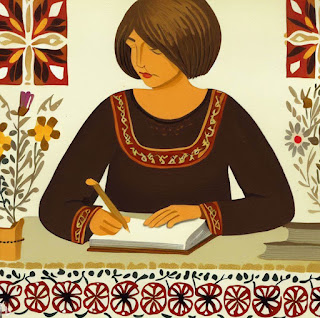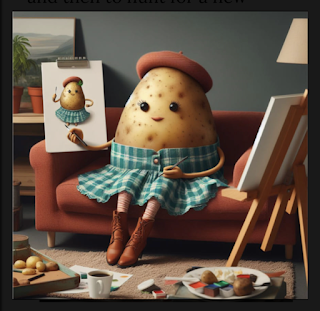Parkinson's: Your Brain on Art
Your Brain On Art
I want to pause first and tell you about my first Harmonica class. It was fun! The class was packed. There were 18 participants. Pam, our wonderful leader, went over some basics.
She told us why it would be
good for us to play a harmonica.
• Research has shown that it will help our breathing
capacity. (Playing around on the
Harmonica left me kind of breathless, which tells me that I really need the
workout.)
• Learning a new instrument also helps the plasticity of
our brains. Which basically means that your brain can rewire, to grow new ways
to handle things.
• Plus it helps your mood to play an instrument either
alone or better yet with friends.
Then Pam showed us how she would like us to hold our mouths, (more like a square, open pucker, -not like the tightly pursed lips pictured in the book. Which I was glad for. I'd tried that and it hadn't worked well for me. Plus, watching Pam demonstrate for us how to position our mouths, in a really CLOSE-closeup on zoom was kind of ghoulish, but fun! She showed us how we needed to clamp our lips on the Harmonica, not blow into it in front of it. It made me think of eating a harmonica sandwich.)
She also explained that the
music in this book is written in color coded numbers. It is easy to understand
(but not to do.) One to ten, matches the numbers above the tiny holes on the
Harmonica. In the book, the numbers are in
blue or red. The red ones mean blow your breath out through the harmonica-
the blue ones mean draw a breath back in through the harmonica.
(That is much harder for me than blowing
out, why?)
We are supposed to play around
on our harmonica this week to try to get used to where the tiny holes are. And
harder yet, start to figure out what tiny number we are blowing into.
We also are to practice the
warm ups every day. Eeekk- 2 concepts, I have always had trouble with- practice
-and every day. (Ask me about how my daily meditation practice is coming along.
Probably better not.)
I can, sort of, now play a very short, squeaky version of
Amazing Grace. (Which Pam did not tell
us to practice. I am such a rebel. Not.)
“Scientific studies increasingly confirm
...The arts in all of their modalities can improve our physical and mental
health, and amplify our ability to prevent, manage, or recover from
disease challenges,”
“Engaging with art, either as maker or user,
can help us thrive.”
So on
to the next art project!
Do
you keep a journal or a sketch book? (The following information came from a blog post
by ? A woman with Parkinson's. I'm sorry, I think I found her in a Davis
Phinney Foundation e mail. I don't remember her name.)
These
are ideas, for a person with Parkinson's, for filling in your sketch book.
First,
she reminds us to: “Resist the temptation
to think you have to be an artist or must fill a page every day.”
And
“Remember, this is your sketchbook and no matter how you choose to fill it, you
will find the process well worth it.”
•
Consider
your sketchbook as a tool to inform and inspire others about Parkinson’s.
Educate your viewer with a page (or pages) of Parkinson’s facts and Illustrate
(draw, cut and paste, use a photo…).
•
Express
how it feels to live with Parkinson’s (yours or someone you know) via art,
decoupage, poem, story, etc.
•
Sketch
or paint everyday objects and relate them to some facet of Parkinson’s.
•
Focus
a page on one color and how that color is expressed in relation to Parkinson’s:
•
Black=the day of diagnosis or when a person
with Parkinson’s moved into a clinical residential setting,
• Orange=determination to finish something
like an exercise session or a challenge, Green=life, living well today.
“Putting images, thoughts, celebrations
and concerns on pages releases them from my mind in a deliberate way that is
truly revitalizing. “
I've kept journals off and on my whole life. In
Yellow Springs, it has been a blessing in my life, to have met for years, with
a weekly journaling group led by Fran Simon.
Except when I am following a book like “The Artists Way” which has you do regular morning pages, I don't write in my journals every day- that regularity bugaboo comes in play here for me. I seem to go in bursts.
I
love to go back through the journals and see what I was thinking at the time.
Sometimes I have added art. I have always loved the idea of carrying a sketch
book with me wherever I go. And I often
do, but usually I also carry a book and end up reading instead of sketching.
The
Isolation Journal's have a 30 day journaling challenge just starting this
month. I thought this quote by Suleika was particularly good: “ It’s absolutely fine for your journaling to be a private
practice. But here at the Isolation Journals, we’ve seen firsthand the power of
sharing our stories—how the “I” becomes a “you” and then a “we.” In each
other’s stories, we can hear echoes of our own, which helps us feel a little
more connected, a little less alone.”
I really like that: “in each other's stories we hear echos of
our own, which help us feel a little more connected, a little less alone.”
So here is my idea: If
anyone wants to share their stories on this blog, send them to me. I would be
delighted. I'd like us all to feel a little more connected, a little less
alone.
Cheers,
Nancy & the Snark


Comments
Post a Comment